Mahonia holly and features of its cultivation
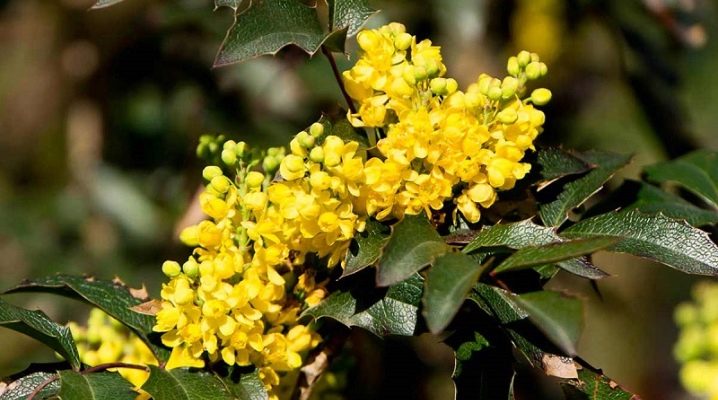
Mahonia holly is popular in many countries of Europe, America and Russia due to its unpretentiousness, the presence of fluffy green foliage and bright flowering. The main feature is the multi-colored color of the leaves depending on the season - from emerald green in spring to burgundy red in autumn and winter.
general description
Mahonia aquifolium (lat.Mahonia aquifolium) is an evergreen shrub from the genus Mahonia of the Barberry family (Berberidaceae). The western states of North America are considered the birthplace of culture. In the northern territories the bush grows to a height of about 100 cm, in the southern territories it grows up to 120 cm.The shrub has a lush crown reaching 120-150 cm in width. Magonia has a strong root system. The roots go deep into the ground, supplying the branches and leaves with the required moisture reserves.
Due to the large number of roots, it gives a lot of growth. The trunk of the shrub is straight, has no thorns, has a pink color in the first year of flowering, after that it darkens and becomes brown. The shrub has odd-pinnate compound leaves up to 20 cm long with reddish petioles. The fruit is oval, blue-black in color, 1 cm long and 0.8 cm wide, edible, sweet and sour in taste. After full ripening at the end of August, the fruits can be eaten.
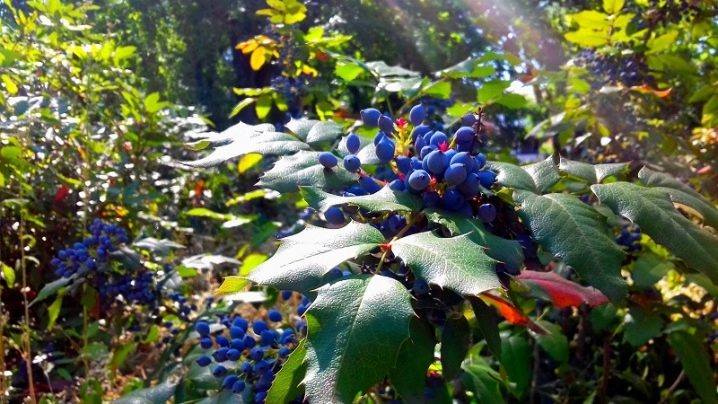
Popular varieties
Most of the varieties of Mahonia were bred by Dutch breeders. However, most of it is intended for a mild climate, with short, warm winters. The type of holly mahonia has decorative varieties - their berries cannot be eaten, and fruit - their berries can be eaten.
There are several varieties of decorative varieties.
- Smaragd - has lush yellow inflorescences, black berries and oval-shaped leaves from emerald to bronze hue. The height of the shrub reaches 70 cm. It is preferable to plant it in fertile, loose and moist soils. In case of damage from cold weather, some branches are restored quickly. The variety is used in winemaking.
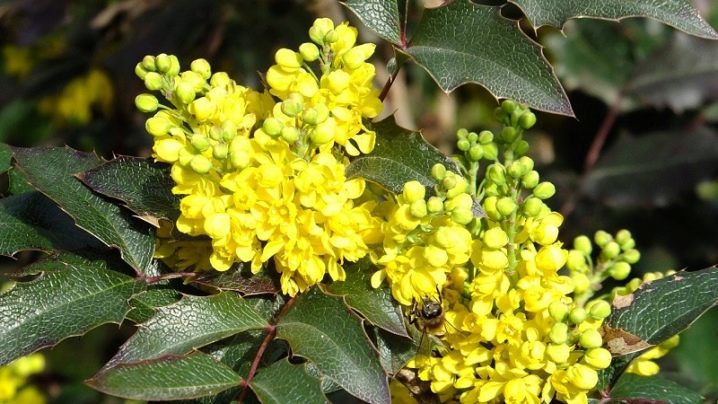
- Orange Flame - has a yellow bloom, blue berries. Pinkish-orange leaves turn burgundy-red by autumn. It reaches a height of 150 cm. Light-loving variety.
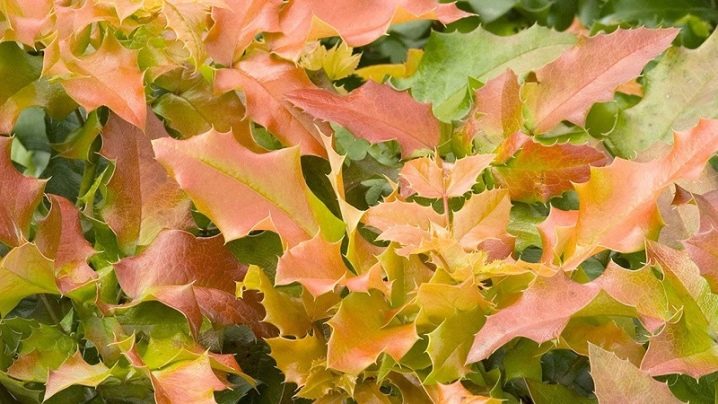
- Compactum - the variety was bred in Holland, grows up to 70 cm in height, has leaves from bright green to bronze.
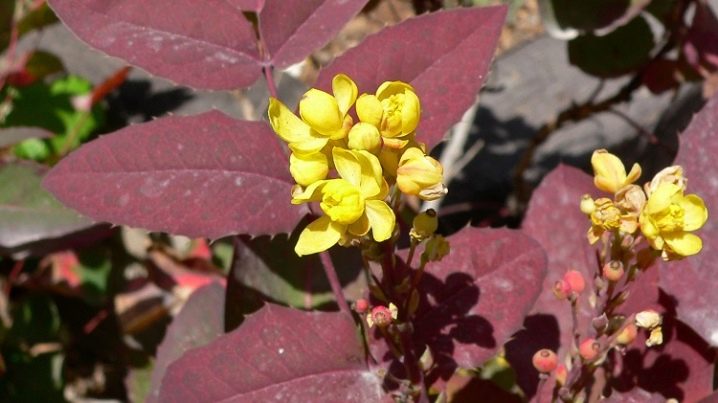
- Atropurpurea (Atropurpurea) - the variety was bred in Holland one of the first, undersized, bright yellow flowering, with a spicy aroma, has dark purple and violet-brown leaves, round berries, 10 ml in diameter, black and blue. The height of the bush reaches 60 cm, the width is up to 100 cm. Wet soil is preferable for this variety, but it will also withstand severe drought. It does not have resistance to severe cold, but in spring it undergoes a quick recovery.
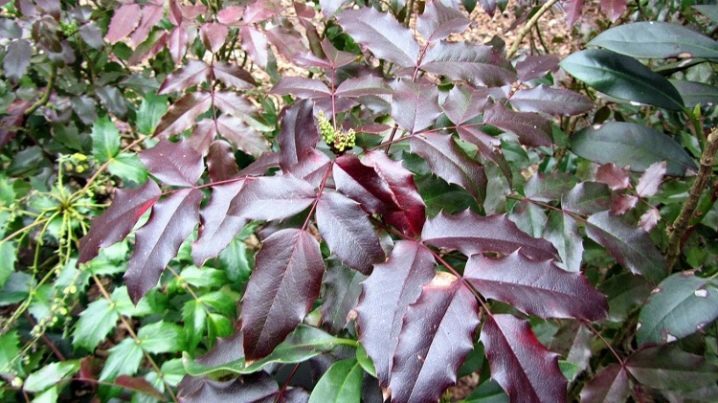
- Apollo - the variety was bred by Dutch breeders, the height varies from 60 cm to 100 cm. The shrub reaches its peak in growth by 10 years. The distinctive features of this variety are thorny shoots with red bark. This variety loves moisture, does not tolerate the scorching sun, so it needs to be sprayed daily with water, not picky about the soil. A plant over 5 years old hibernates without requiring shelter.
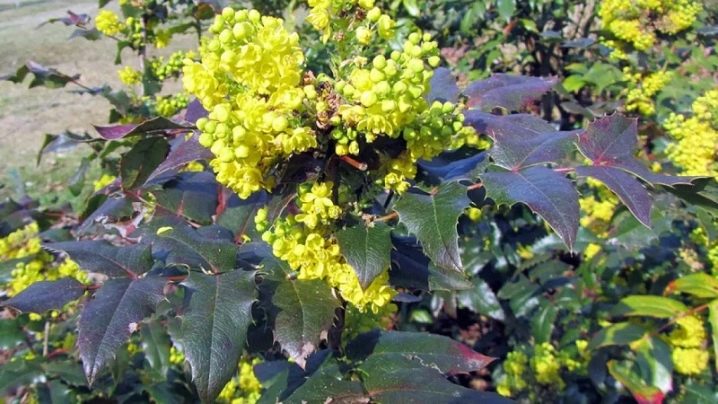
There are several fruit varieties.
- Natakha - grows up to 150 cm tall.Berries are oval, blue-black, with a bloom of blue color, contain vitamin C. The yield of berries is up to 1.5 kg per year. The leaves are dark green, curved.
- Mermaid - the variety has a high concentration of vitamin C. It is useful for viral and bactericidal diseases.
- Timoshka - the bush grows up to 150 cm in height. Berries are small, with a moderately sour taste, up to 14 pieces per cluster.
- Sweetheart - the sweetest variety, contains from 6 to 8% sugar in the composition. Reaches 150 cm in height. Berries on a tassel up to 15 pieces. The main advantage of the variety is its berries, which do not crack during heat treatment. The leaves are green, but in the autumn they partially acquire a burgundy and brown-purple color.
Given the climate of central Russia and the Moscow region, the following varieties will be the best choice for growing: Apollo, Smaragd and Atropurpurea. These shrubs are the most frost-hardy and unpretentious to the climate.
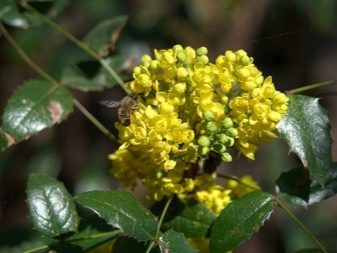
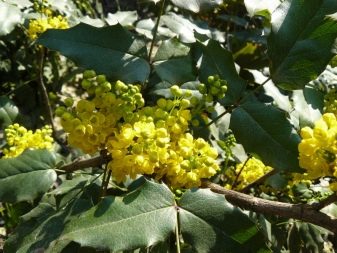
Landing
When planting Mahonia, you should choose shaded places, since in nature it grows mainly near tall trees. When planted in open areas, the leaves of the bush suffer, getting sunburn, which is reflected in the appearance of the bush. For a correct fit, you should follow the recommendations of specialists:
- choose a place for landing protected from winds and direct rays of the sun;
- the shrub is unpretentious to the soil, but it is better to plant it in fertile, soft soil with drainage;
- the shrub should be planted in the spring, immediately after the snow melts, so that the plant has time to take root;
- fertilize the soil with a mixture of humus, sand and turf;
- do not compact the soil around the roots to better stimulate development;
- plant a seedling in a planting pit 50 cm deep, and at a distance of 100-140 cm from each other;
- the root collar should be at ground level;
- after planting, water and mulch abundantly.

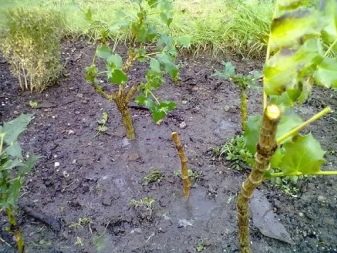
Care
Magonia is distinguished by its unpretentiousness, quick adaptation to any type of soil, even clayey. With a powerful root system that penetrates deep layers of open ground, it can withstand even dry weather. However, to maintain its appearance, it is worthwhile to regularly care for the plant.
- Watering. You need to water an adult plant three times a week, 20 liters of water per bush. Moistening of young seedlings is carried out every 3-4 days, taking into account dry weather. To preserve the green part of the plant, spray the leaves with a hose every evening. In cooler regions, twice a week is enough.
- Loosening. This procedure is carried out after watering for better oxygen supply to the root system, which has a positive effect on the rapid development of the shrub. And also regular loosening does not allow water to stagnate, prevents the formation of an earth crust and the appearance of weeds.
- Top dressing. In autumn, it is advisable to carry out mulching with humus or potassium-phosphorus preparations, for example, potassium monophosphate or superphosphate, to increase the fruit. In the spring, nitrogen-containing fertilizers are added around the trunk - 200 grams for one adult bush.
- Pruning. Every spring and autumn, damaged branches, thin, weak shoots in the lower part of the trunk, shoots growing inside the crown are cleaned. The formation of the crown for lush flowering is carried out by trimming the tops of the shoots in the year of planting, you should leave 15-20 cm in height from the root. Pruning Mahonia should not be done when the plant is in bloom. In the spring, the next year after planting, the shoots must be cut in half. Pruning an old bush is done to rejuvenate it, so a little less than half of the shoots are cut from the root, and 40 cm of branches are left. To create a special atmosphere in the garden, the crown of Mahonia is formed in the shape of a ball, such a haircut should be done at the end of April, in May, after the end of the frost.
- Wintering. Winters in the middle zone and the Moscow region are tolerated by Mahonia without any problems, although the plant does not differ in winter hardiness.If the upper leaves are damaged during frosts, then in the spring they are cut off, and the bush comes to life quickly.
During severe frosts, Mahonia is covered with non-woven materials, and straw is sometimes laid on top. Tall bushes are tied to a support to avoid branch breakage.
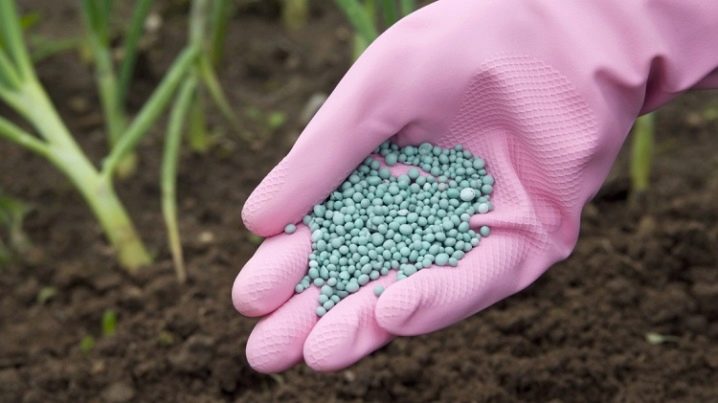
Reproduction
You can propagate holly Mahonia in four ways:
- seeds,
- layering,
- dividing the bush,
- by cuttings.
Seeds are rarely propagated due to the laboriousness of the process, since with this method the first flowering will occur in 5 years. This method is chosen when breeding a new variety, or if there are no other planting options. If you plan to plant seeds in the fall, you should adhere to the plan:
- the collection of seeds is done from fully ripe berries in September;
- immediately after collection, they are sown into a prepared furrow to a depth of no more than 1.5 cm in open ground;
- cover with leaves;
- the first shoots should be expected in May;
- after they are seated in pots or open ground.
If sowing is planned in spring:
- it is necessary to carry out stratification within three months, the temperature is not lower than 3-5 ° С;
- the sowing site is covered with a film, and sprouts are expected to appear, periodically airing and moisturizing;
- seedlings dive.
Using seed reproduction, you need to prepare for biological characteristics that differ from the mother bush in the future bush.
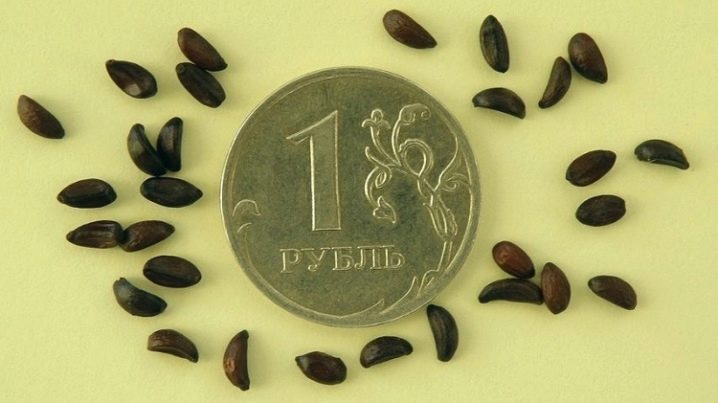
Propagated by layering as follows:
- shallow pits are prepared under the lower branches;
- the middle of the lower branch is lowered into the pit, and reinforced with an arc-shaped wire;
- rolling with earth;
- the layering is ready for separation after it has a separate root system;
- planted in a prepared place.
By dividing the bush, reproduction is carried out with the help of a new shoot, which is given by shrubs starting from the 9th year of flowering. Shoots appear annually. The disadvantage of such reproduction is a weak root system of new shoots, therefore, before transplanting, young shoots should be kept in Kornevin's solution for at least 7 days.
Reproduction is carried out by cuttings in early spring:
- take a young shoot with swollen buds;
- cuttings are prepared - the lower cut must be made at an angle, the upper cut is made straight, each has six buds;
- the cutting is placed halfway in water with a root former until the roots appear;
- the first roots on the buds immersed in water will appear in two months;
- after the roots reach 7 cm, they are planted in open ground and covered with plastic bottles, after cutting off the neck;
- for the prevention of fungal diseases, watering with a fungicide is done;
- after two weeks, the shoots will take root, the bottles are removed.
Reproduction by cuttings retains 100% biological characteristics identical to the mother bush. Therefore, in most cases, gardeners use this particular breeding method.
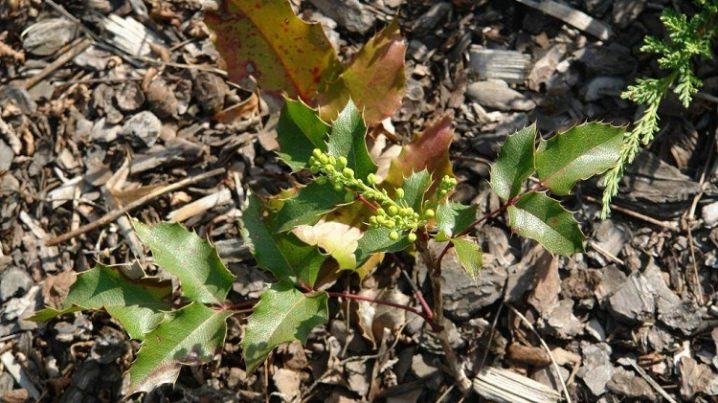
Diseases and pests
Mahonia holly shows high resistance to diseases and pests, but infection with some diseases is not excluded. The appearance of rust on the plant is evidenced by the appearance of copper-colored tubercles, rapidly spreading through the leaves of the bush. To prevent spread, damaged leaves should be removed and destroyed outside the garden. With phyllostictosis, brown, growing spots appear that affect the entire bush. The leaves dry up, the development of the plant stops. Cleansing the affected leaves and treating them with a fungicide will help to destroy the infection.
Powdery mildew is characterized by the appearance of a white coating on the lower and upper sides of the sheets. Inflorescences and berries also suffer. If a disease is detected, the shrub must be treated with Bordeaux liquid or fungicides. Infections dry out the foliage and kill the shrub without proper treatment. From harmful insects there are attacks of aphids and scale insects. In case of illness, you need:
- carry out the treatment with soapy water;
- treat with an insecticide, for example, "Karbofos";
- remove and destroy damaged leaves;
- annually treat with fungicides in the spring.
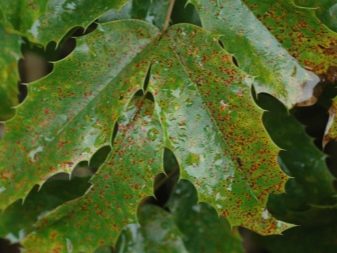
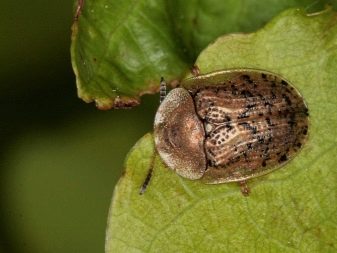
Possible growing problems
If you do not follow the elementary rules for caring for the plant, do not carry out timely treatment for diseases and pests, do not water, prune and fertilize the plant, then irreparable problems of growing a shrub associated with its diseases will arise, up to its death.
Application in landscape design
The ornamental shrub of Mahonia is popular in the landscape, as it is able to decorate the territory in such options as:
- edging of flower beds, lawns and paths;
- framing stone compositions;
- creation of hedges;
- compositional addition to trees and shrubs of other varieties.
It doesn't take much effort to grow Mahonia. If you follow all the rules for planting and caring for a plant, the garden takes on a beautiful-looking shrub, with a pleasant aroma and fruits that are beneficial to health.
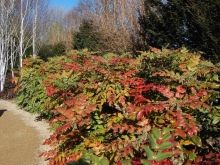





































































The comment was sent successfully.